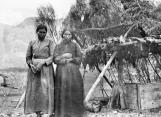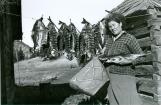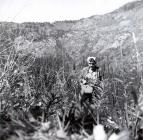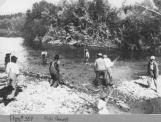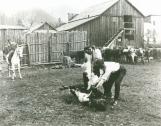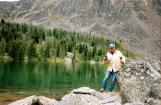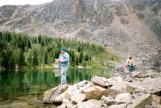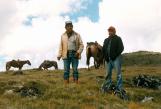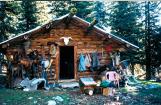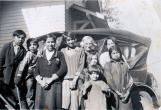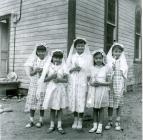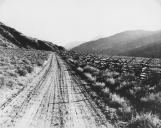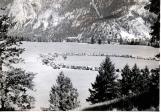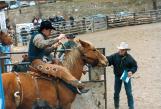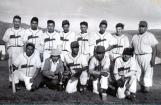

South Similkameen Museum
Keremeos, British Columbia
1
The Indian (Indigenous) people of the Similkameen valley have a history with the land that spans thousands of years in and through theareas in what is now Washington and in British Columbia. The area they origianlly travelled from Brewster Washington over to Montana, up to Arrow Lakes in British Columbia and through the Similkameeen Valley west to Hope. The Similkameen people also fished and spent time in the Lytton and Spences Bridge areas.Language
Official language of the Similkameen people is the Smilkamix language. This language has been replaced by the Okangan (Syilx) Language due to the number of deaths of community members in the small pox epidemic that occured in the 1800's.
Many of the Similkameen poeple could converse or understand the following languages
Okanagan
Thompson
Methow
Flathead
Chinook was the Traders Language used by indigenous and non indigenous peoples.
The Similkameen people could also understand Suswap language.
3
Village SitesOriginal encampments were chosen strategically. The areas had to have look out points so that the people could guard against intruders. Wood supply, water supply and food sources were important to the the Similkameen people. The existence of hunting areas and supplies of roots and berries had to be considered to sustain the people as they lived seasonally.
Some of the better known village sites were:
Driscoe Island
Palmer Lake
Ashnola to Chopaka (along creeks and rivers)
Ollala
Princeton (along creeks and rivers throughout the valley)
Skagit
Hope
Tulameen
To this day, there are new and continued findings and evidence of encampments and travels of the people. These are being re-discovered through modern archeological practices.
4
DwellingsPithouses made of wood, hemp and mud
Tule Shelters were made of reeds, wood and hemp.
Ntamplken lodges were made of reeds, wood and hemp rope
Summer Lodges were made of poles and fir boughs
Winter Kickwillies were made of poles, grass, bark, tules and hides and later canvas
Modern dwellings were Log homes and stick built homes.
During Hunting season, the people would build lean to structures as a means of temporary shelter.
5
Pierre John and Dan Tuma playing an accordian and a trumpet1890 to 1905
Hedley BC, Canada
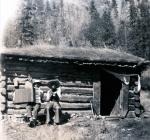 Credits:
Credits:Lower Similkameen Indian Band
6
Traditional Form of DressBuckskin clothing made from the hides of deer, elk, and moose.
Cedar hats, skirts, cloaks were made from cedar roots.
Grass and Hemp Clothing were made from the grasses and hemp plants native to the area.
Fur Garments were made from the animals that were trapped in the area.
Chiefs Head-dress was a round head-dress adorned with eagle feathers.
Decorative Formal- Dentallia shells, abalone, buckskin gloves and beads.
Ceremonial Practices
Sweatlodge used for cleansing and for spiritual purposes
Potlatches were carried out as a social function, for community gatherings and for ceremonial purposes
Healing
Rights of passage training was carried out for young men and young women
7
GovernanceOriginally there was a Hereditary Chieftainship line within the greater community.
Later each village of the community which included, Chopaka, Similkameen, Ashnola, Chuchuwayha and Tulameen, Palmer Lake was led by a Chief that took care of the needs of that particular part of the community. For Chiefs to maintain control, they had to have the saction of the tribe.
A group of advisors known as the wise men and women or the good men and women helped the Chiefs with decisions and with discipline of the people. The discipline of the people. The discipline of the people was strict and maintained a high standard of conduct that earned community respect. In the event that drastic measures were to be taken, discipline somtimes resulted in banishment from the community for a set period of time or banishment for a lifetime.
Children were disciplined at an early age, particularily if they were appointed to be future leaders, advisors or warriors.
The Canadian Federal Government changed the original governance system to an election system. Under the regulations of the Indian Act there is to be one Chief per community. There is to be one Council Member for every 100 people after the initial 100 that substaniates the Chief's position. The Community later changed the election system to a staggered term election system to meet the current system and to integrate a form of its own governance. The new system elects 2 positions of the 4 every 2 years so that the terms are staggered. Each Chief or Concil representative sits in the elected position for a 4 year term.
11
Lore and LegendThe region and the valley is wrought with sites where one of our many teachers Coyote (better known as trickster) played out his antics always wanting more for the people but often falling short due to his own egotistical and self motivated ways.
In the time before human existence, Coyote was responsible to prepare the lands for our peoples arrival. He was the character that gathered the animal people together to decide what was to become of the people. Information of this occurence can be found in the story "How food was given". He connected the original interior plains people through establishing relationship in and amongst the tribes. This information is found in the story "How Coyote Brought Salmon". Information can be obtained from the Nation's "Enowkin Centre" which is the Cultural and Education centre of the Okanagan people. The Enowkin Centre is located in Penticton B.C.
Many of these relationships were further developed as people evolved to need the resources the animal people provided for them.
12
MiningThe Similkameen people have a long history of use of natural resources of the area in terms of mining its valuable resources. Originally people relied on such minerals and quarry products as:
Jade-women's pipestone and use in accessorizing dress.
Cobalt-used to make implements and tools.
Ochre-used as a paint and for ceremonial purposes. Was amongst the highest valued trade goods.
Flint Rock-used to make spears, tomahowks and arrowhead.
Soapstone-used for carving.
Copper-used to make necklaces, used in regalia making and was a trade item.
Clay-was a trade commodity between Nations. It was an important material used in food preparation.
Cobbled bedrock for food and medicine corn crushers.
Volcanic rock used in the sweatlodge.
Gold-was not used by the Similkameen people as its properties were considered a bad omen. Historically all Similkameen people who used the gold either died or their families came upon harm or hurt in some way.
As Similkameen people understood the importance of natural resources, they have maintained a close connection to the land.
13
LandsSimilkamix people were originally a nomadic people that moved from locations in accordance with the availaibilty of foods and the climate of the area. Time was also spent between communities. It was not unusual for families from another area for months at a time. Many of the communities could do this as there was much inter-marriage between communities; thus a large extended family spanned between Nations throughout the interior.
Amongst those that travelled between communities were the runners, they also kept information flowing between tribal groups of people.
The following is an example of some (though not exhaustive) of the nomadic areas often spoken of.
January Tulameen winter camp grounds (deer hunting)
Women camped at Camp de Femme north end of lake (Frembd Lake)
Men camped at the south end of the lake.
Lorne Lake (original Similkameen River channel) (spuklic)
February Palmer Lake-fishing (ling cod and trout)
March Palmer Lake-fishing (ling cod and trout)
April Chopaka (roots)
May Spotted Lake, Kilpoola, Ashnola, White Lake (roots), Falkland, Enloe Dam, Palmer Lake-Bull Frog Mountain (ling cod and trout)
June Kilpoola (deer hunting) Molson Washington
July Ashnola (deer hunting and berry picking)
August Paul Creek to Sterling Creek berry picking and root digging
September Lytton, Douglas Lake, Princeton flats Roots
October Smith Creek and John's Creek Hunting
November Tulameen-Lake de Femme and Otter Lake
Winter Camp grounds (deer hunting)
December Tulameen Winter Camp
Spring burns were a method of traditional environmental enhancement.
The people were aware of the importance of sustainability and living in accordance with preservation of their traditional hunting grounds. For this reason, there was a disciplined practice of rotating picking picking or hunting grounds over a period of time. There were individual who were responsible for monitoring the food sources, to ensure they were not over picked or over used.
This is evident to this day, where one need only view the pristine condition of lands were the Similkamix people reside and the backcountry where they have resumed their responsibility as caretakers of the land.
Prior to contact there is much history of tribal peoples being reliant upon each other to provide the material and food staple needs.
15
Inter Tribal Trading SitesPrior to contact, the Tribal Nations would gather seasonally to trade goods with neighbouring peoples. At the various sites listed there were encampments where people gathered upwards of 2000 - 5000 people.
In these areas, the tribes would engage in games or competitions as a form of social gathering and to demonstrate their strengths as a people.
Some of these areas included but were not limited to:
Twin Lakes Flats
Princeton Flats
Driscoe Island - Oroville WA. Fishing Season and Trade Fair Time
Coyote's Dam, Salmon Fisheries - near Oroville WA.
Rock Creek
Montana - (Pipestone)
Brewster, WA
Tulameen
Skagit
Spences Bridge
Border Creek trading ground for candlestick oil. Eulican fish.
Skagit and Similkameen Guard Rocks
Hayes Creek where it meets Osprey Lake and Trout Creek is a major village area.
Lake de Femme - was origal encampment of Chief Black Eyes. This areas was one of the largest winter encampments, estimated at 2200 people.
16
Internal Community TradingThe elders have told oral stories that in the times of pre-settlement the neighbouring communities and nations of indigenous peoples were provided for after the needs of the local peoples. The neighbouring people and communities took what they needed for food and staple caches. The tribes knew where caches were kept and would bring their trade goods for the resources they needed. Similkameen people had their own recognized camp at each event whether it be social, tribal wars, hunting, food gathering, or fishing camps. For example there were annual trades, such as berries for salmon. Medicines were also gathered by communities for use by the people.
Some examples of trade goods were:
Export Import
Ochre Sweetgrass
Tobacco Salmon, fresh/dried
Hemp Euligan
Soapstone Dentallia Shells
Wild Teas Grizzly Bear Claws and Teeth
Berries Pipestone
Horses Trade beads (Hudson's Bay)
Abalone
This inter-dependent relationship resumed upon an influx of settlers to the Similkameen Valley and formed the basis for the spirit of cooperative living that continues between the communties of Native and Non Native peoples today.
As Similkameen people were settled onto reserves esablished by the federal government, locally the people would stop to camp over with the Marcel Family on their way back from Penticton. Most families traveled on horse and buggy.
17
IntegrationThe migration of non native peoples in the valley came as a result of establishment of Hudson's Bay posts in the area. The area was also explored by missionaries that were sent to live amongst the people.
The original people came from the east and from the south. It was noted by Hudson's Bay personnel that Similkameen people could not be readily converted into trappers for the company, due to their wealth and independence as a people.
Some of the animals that were hunted and trapped in the area at the time of the Hudson's Bay Trading era were:
Hunting Trapping
Elk Lynx
Lynx Squirrel
Moose Otter
Groundhog Bobcat
Sheep Beaver
Bear Weasel
Deer Muskrat
Rabbit
Fox
21
Betty Terbasket and others root digging at White Lake( west of Ok Falls BC) near the Obervatory.1940
White Lake, near OK Falls BC
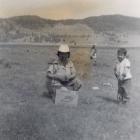 Credits:
Credits:Betty Terbasket
22
FishingKickinee at Trout Creek and Misseula Lake
Spuklic (Burdock) at Palmer Lake and Lorne Lake
Salmon fishing at McIntyre Bluff and at Coyotes Dam near Oroville Washington
Trout fishing at local creeks and rivers
Fish Trades occurred with the Stolo, the Nlakampemx and Nicola people.
Euligan (Candle Fish) with the Coastal villages.
Hayes Creek was a major village area
Tulameen was a major encampment by Chief Black Eyes of the Similkameen. The encampment was settled by 2200 people.
24
Settlement of the AreaFollowing the settlement by Hudson's Bay Company the valley was invaded by settlers moving in for the Gold Rush. As settlers were coming forth the area was in danger of being taken over by the United States. The Similkameen People made agreement with the representative of the Queen of England that they would co-exist with newcomers to the area. Upon initial agreement it was decided that no one other than the Queen could change the initial agreement made with the Indigenous peoples of the land. This was a decision made and understood by all native peoples of the area throughout the Thompson, Okanagan and Similkameen areas.
The agreement was that "As long as the major rivers flowed and the sun rose on the lands, the people of Similkameen would be respected. They would maintain use and occupation of the lands and would contiue to use the lands resources for sustainability of its peoples without interruption forever. " This agreement formed the basis for what later became the BC Flag to document the same said agreement.
25
Foods of the Similkameen PeopleThe Similkameen were hospitable people that helped the orignal settlers by providing and teaching them about foods, medicines and shelter. They also taught them about the area and the trails. Many of the foods and materials were used by our people and continue to be used today.This is a general list of foods and materials used.
Food Cultural Materials
Bitter root Hemp Rawhide
Camas Cedar root Bone
Wild Potatoe Birch Teeth of animals
Wild Celery Sinew Turtle Shell
Wild Onion Flint Hoofs
Yellow bells Soapstone Eagle feathers
Mushrooms Ochre Hawk feathers
Saskatoons Yew Flicker feathers
Chokecherry Iron Wood Animal pelts
Huckleberry Buckskin
Wild raspberry Rawhide
Wild strawberry Corn crushers
Blackcaps Cottonwood
Oregon Berry Willow
Elderberry Pipestone (traded)
Blueberry Sweetgrass (traded)
Wild rose Obsidian
Wild tea Pemican
Sunflower Abalone (traded)
Dried meat Dentallia
Smoked and Cured meat Reeds
Service Berry
27
Farming and RanchingWild horses were moved from Palmer Lake through the valley to Princeton. Horses were taken to Oliver for grazing. The Similkameen people providedorses for World War I and World War II. At the peak of the horse runs there were approximately 1500 head in the Similkameen Valley. At this time, Similkameen people were consumers of horse meat.
The Similkameen people were well known fo rtheir outstanding quality of horses and horsemanship. In the past, Similkameen people were the supplier of horses to the Russian army. The 1960's saw the destruction of the Horse herds as there came to be a bounty out for the horses. As the valley was settled, there came to be a perceived over abudance of horses.
As communities were further agriculturally developed, they incorporated cattle ranching as a way of life. There were many successful ranches that existed within the community. Some of these included:
Early Farmers and Ranchers Yakumticum, Showdy Ranch, Narcisse, Billy Francois, Shorty Michelle, Jimmy Robinson. Indian Edward, Qualtier Ranch, Allison Brothers, Showdy Creek Ranch, Harry Robinson, Abraham Louie, Hans Richter, Willie Terbasket, Eneas Nehumpchin, Paul Terbasket, Alex Skius, Joe Dennis, Johnny Chuchuwasket, Harry and George McGinnis, Pierre John Ranch, Johnnie Holmes, Charlie Allison, Wici Allison, Harry Squakin, Pinto Jack.
Current ranches include. Qualtier Ranch, Allison Ranch, Louie Ranch, Gottfriedson Ranch, Blind Creek Ranch, Henry Dennis Ranch, Robert Dennis Ranch, Turtle Creek Ranch, Ralph Bent Ranch,
29
Wheat Harvest at what is now Blind Creek Ranch above Cawston BC1953
Blind Creek, Cawston BC, Canada
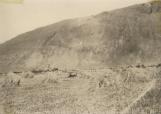 Credits:
Credits:Lower Similkameen Indian Band
30
Trading within CommunityIt is a well known fact that at the time of the depression, Similkameen people assisted the off reserve community by providing employment on the established Indian ranches. They also provided a good supply of food from the gardens and fruit trees. They would also travel by train to Keremeos to trade crafted buckskin items for dried goods at the Ben Williams store and at the Grist Mill for flour.
Internally within the community, the people had a trade system that provided for communities within families. ie. Farmers would trade other families for butter and eggs in turn for fruit and vegetables and meats.
37
Similkameen TerritoryThe lands of the Similkameen included the valleys from the Skagit to Christina Lake and from Vernon to Brewster.
The lands of the Similkameen people included areas that were expropraited by the Federal Government to provide for the Veterans that returned from the war. These lands were taken without consultation of the Similkameen people.
To date there remains existing Specific Land Claims that will at some point be addressed between the Federal and Provincial Governments and the Indigenous peoples of the nation and the community.
When reserves were established, the lands set aside for the Similkameen People were;
IR#1 the entirety of Cawston Flats
IR#2 Similkameen
IR#3 Kilpoola
IR#4 Narcisse's Farm
IR #5 from Upper Cawston Flats through including Rocking Chair Ranch
IR Keremeos Creek the flat of Bear Frasch's through to Sportsman's Corner (originally a village site)
IR#6 Blind Creek
IR#7 Chopaka North
IR#8 Chopaka South
IR#9 Alexis
IR#10 Ashnola
IR#11 John's Creek
IR#12/12 A Keremeos Forks
IR#13 Range lands
39
EducationThe students rode on horseback to a small school house located near the United States border. The school was a 14' x 20' Log and Sod schoolhouse. The second schoolhouse was stick built and was located further south of the original location but was placed on the creekside. The second schoolhouse held approximately 30 students. Of the 30 students 1/3 were native students, 1/3 were local students and 1/3 were students of workers from the mines.
As with all Native peoples, the Government made it mandatory that Indian children attend Residential schools. The children were picked up by cattle truck and sent originally to the Residential school in Cranbrook. Upon closure of the Cranbrook school the children were sent to Kamloops Residental School. The Mormon recruiters came into the Similkameen Valley to pick up children for conversion to their faith and for attendence to school. Parents of the children caught up to the group in the United States and brought the children back home. Many of the Similkameen children also attended the Mission School at Omak Washington.
Following closure of the Cranbrook Residential school, students attended the public school that is now Cawston Hall. Later the Cawston School was constructed and then further renovated to its current state.
41
Sylvester McLean at the School house in Chopaka1970's
Chopaka BC Canada
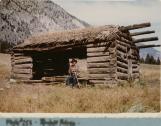 Credits:
Credits:Lower Similkameen Indian Band
42
Merchants of the SimilkameenThe Similkameen people traded buckskin moccassins and buckskin gloves, vests and other materials they had for basic staple products that were brought by merchants. These included such things as flour, coffee, sugar, rice, textile material to make clothing and blankets, shells for hunting and other basic goods. The women would make the traditional trade items during the winter season and in the spring they traded for supplies that lasted the families for half of the year.
Originally the Similkameen people did their trading with the Nighthawk General Store owners and later Princes Department Store. Prior to the bridge being built, the Similkameen people were considered to be United States citizens.
43
Nighthawk General Store1960's
Nighthawk Washington, USA
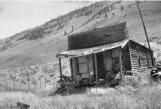 Credits:
Credits:Ann Briley Collection, Okanagan County Historical Museum
44
ReligionThe people of the Similkamix practiced beliefs of their culture. Following settlement, the people were prohibited from practicing ceremonial or spiritual rituals. To engage in Traditional practices would result in arrests and charges being made. The Similkameen people were converted to the Roman Catholic religion.
Today there is a diversity in belief ranging from Traditional Indigenous beliefs to a multitude of contemporary religions and Christianity.
The Spiritual practices of the Similkamix people continue today. Many of the spiritual practices were introduced by coyote. There are many spiritual sites and many ceremonies that were given for our people to follow. These are found in the stories of the people.
46
InfrastructureTransportation of the native peoples was by water and by trek over the land. The people built rafts and canoes to travel the lakes and rivers in the valleys.
The Similkameen people had horses well before the invasion of the Spaniards. The horses began to graze wild in the hills and mountains of the area. After settlement, the people relied on horse and buggy. There were places of encampment all through the valleys where travellers would stay during their journeys between tribal communities.
Transport
Most highways that are used today were built on the original trails of the Similkameen and Okanagan people. What later became Allison pass was the original pack trail that belonged to Nora Yakumticum who ran a pack train from Greenwood to Hope and the Coastal areas.
Roadways
Travel occurred by horseback from Chopaka and Similkameen to Cawston and to Keremeos. Pre 1955 the community of Chopaka used the Chopaka road to Nighthawk, USA road and travelled up through Highway 3 to Cawston and Keremeos. The original highway was what is now called Barcelo Road and it joined the main route near the town of Keremeos.
Electricity
West Kootenay power was put in at Chopaka in 1965 onward. The company changed to Aquila and Fortis.
In the original agreement with West Kootenay, the company was to install poles to residents on reserve for free in exchange for the powerlines that were placed within the community.
Telephone
BC Telephone Company
Telus
Telephone service to the area started in community as 2 and 5 party lines. Each house had a different ring tone in their homes to denote whether the call was meant for their household.
Railway
Vancouver Victoria and Eastern Railway
Great Northern Railway
Burlington Northern Railway
From the period 1906 until 1955, native peoples of the Similkameen Reserves travelled by train from Chopaka and the Similkameen into the towns of Princeton and Keremeos.
Gaslines
BC Gas
Inland Gas
BC Gas Southern Crossing
Tarasen Gas Inland Pacific Connector
49
The old Train Station at the Chopaka-Washington Border on Chopaka Indian Reserve1906-1930
Chopaka BC Canada
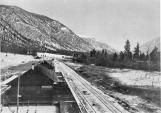 Credits:
Credits:Ann Briley Collection, Okanagan County Historical Museum
50
Recreation and AthleticsChopaka Easter Rodeo
The Chopaka Easter Rodeo started out as an Easter Sunday family day and picnic. The community would gather to watch baseball after church. Later, the young men would try out stock at the Allison Ranch. Years after the day became a formalized jackpot rodeo. The rodeo continues to be an annual event put on by the Chopaka Rodeo Committee.
The Chopaka Easter Rodeo has been the starting ground of many successful rodeo competitors and participants. Local Native people have been involved in rough stock categories such as saddle bronc, bull riding, bareback to events such as calf roping, team roping, steer wrestling, barrel racing, wild cow milking, calf scramble, pee wee barrel racing.
Chopaka was also the home of the Junior High School Rodeo for many years. The rodeo was organized by Archie and Joyce Jack of Penticton.
Similkameen Rodeo Club
The Similkameen community has long been a ranching and farming community. There has been much involvement in the Old Paul Rodeo that occurred at Blind Creek behind what is now the baseball diamond.
May Day Rodeo
Representation many of the local men and women participated in the Elks Rodeo held in May in Keremeos. There have been a number of young local Native women that have been crowned Royalty representing the Elks Rodeo in the Rodeo Circuit.
56
BaseballBaseball has long been a sport of the Similkameen People. The sport started in the fields and in the sage brush in the community where the young people would play scrimmage games amongst one another.
Later the teams were managed and run by the coach who carried the team from reserve to reserve throughout the Okanagan and Thompson areas. The Similkameen team was known for its skill in the game.
The most notable players were Jim Terbasket (pitcher) and James Squakin (Back Catcher). This pair was scouted by the big leagues to play professional baseball but did not follow through to enter the leagues.
Over the years, the teams have joined in the local recreation leagues and many players from both the native and the local off reserve communities continue to play all forms of baseball and softball.
58
BasketballThe Similkameen Community is well known for its skill and enjoyment of basketball. Having never had facilities of its own, the community is renowned throughout the British Columbia Native Amateur Athletic Community as being fierce competitors in the game. There have always been women's teams, men's teams and co-ed teams.
The best known player to come from the Similkameen Native Community was Rainbow Edward whose talent led the Similkameen Secondary School to BC Championship. Rainbow Edward was known throughout British Columbia for his abilities and skills on the court.
School Sports
The indigenous people in the Similkameen valley have a reputation for being excelling athletes. Their contributions made to local sport sucesses have been realized over many generations. Many local school sports records were broken by Male and Female athletes in team sports and in track and field events. Thier contributions continue to play a valuable part in the school athletics and competiton.
59
Cultural RevitalizationCanoe Building
The Similkameen people commenced building of canoes after not doing so for 100 years. At the urging of Okanagan elder Louise Gabriel who envisioned a way of re-connecting the people to waterways and reconnecting the communities to each other, the Okanagan Nation communities came together to build the first dug out canoes. Since the canoes were built, many families have dedicated time and effort to the skill and the knowledge.
In appreciation for bringing forth the knowledge, recognition goes to Gordon Marchand of the Okangan Indian Band. Gordon was trained by his elders to wait for a time when the people would once again need the knowledge to carry on the tradition of canoe building. Locally, Herman Edward has acquired the expertise to continue guiding new learners to carry on the work.
Similkameen Pow Wow
The Similkameen Pow Wow was first held on Labour Day weekend. The event was changed to coincide with the May Day Long Weekend Celebration in order to draw more participation and spectators.
The Pow Wow is a competitive event that is Social in nature. Though not a part of Similkameen Tradition, pow wows provide a venue for traditional people to engage in Dance and Singing. The particpants compete to win monetary prizes. The pow wow became renowned for its rich and colorful entertainment provided to all people, native and non native alike. People enjoyed the beauty and the skill of participants in song and dance.
The cost of the event became a factor in the pow wow becoming discontinued.
61
SocializationPrior to settlement, marriages were arranged between families and between communities. If a man was wealthy, a good provider and could esure that the women were taken care of, he was afforded the respect of taking on more than one wife. Often times, this was done by Higher Chiefs within the societies. This set up the inter-nation relationships and ensured that there was good repoire beween communities and between tribes.
The trading or taking on of wives within the societies would occur during inter tribal encampments. At this time, there would be demonstrations of abilities and skill through gaming and competition. The communities would come together to socialize in the true sense of the world. At this time, there would be no weapons or guard against one another.
Within the common community, parents would discuss the future of their children as husband and wife. Throughout the young peoples lives, the families would exchange gifts between families to maintain the agreement of the arrangement. The practice of arranged marriages ceased in the 1930's. As marriages were no longer arranged, courtship would occur at Social Gatherings between communities. Marriage became the decision of individuals.
If men were abusive to their wives, sisters or mothers, the man was disciplined by the wise men of the community. Women were disciplined if they brought their husband's name or his character in disrepute. The wise men would also deal with the women.
Upon settlement, many of the newcomers took up companions from the native communities. This established a long term relationship with the community to ensure survival but also provided newcomers access to the lands within the traditional territory. Once settlers had established themselves in the area, the Native women and the children were returned to the community. The settlers would bring in new wives from european countries to join them in this country.
After the invasion and attack by the Spaniards in the Similkameen Valley, it was decided within the community that the Similkameen people would not engage in relationships or marriage with Spaniards
.
There were a number of ceremonial practices that occurred over the duration of life. These included ceremonies for birth, rights of passage, name giving, vision quests, sundance, marriages, appointments of leaders, social protocols, warring, deaths etc.





